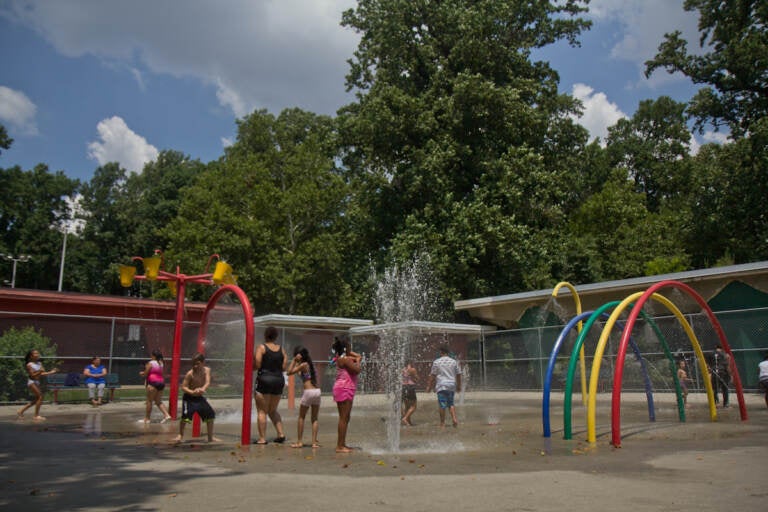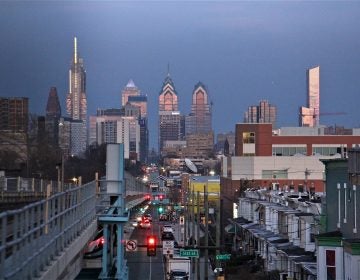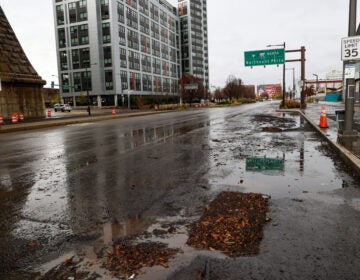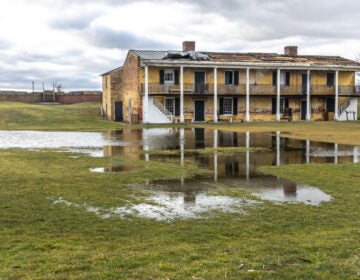2022 has been one of Philly’s warmest years on record
“This is the new normal,” one expert said. “And that should be alarming.”

Families enjoy the sprinkler park at Ferko Playground in the Juniata Park section of Philadelphia during a summer heat wave on July 20, 2022. (Kimberly Paynter/WHYY)
Despite last weekend’s uncharacteristic and brutal cold snap, 2022 ends as one of Philadelphia’s warmest years on record.
Experts say that’s consistent with human-caused climate change.
“This is the new normal,” said Gregory Jenkins, a professor of meteorology and atmospheric science at Penn State University. “And that should be alarming.”
As of Monday, Philly was having its 3rd warmest year on record. Actually, 2022 has tied for that distinction — 1931, 1998, 2017, and 2021 share the 3rd place through Dec. 26, according to the National Weather Service.
While it’s possible that the final five days of the year could change the 2022 ranking, National Weather Service meteorologist Amanda Lee estimates it’s likely to end up “very similar.”
Last weekend’s cold snap bumped Philly out of second place for warmest year on record, tied with two other years. New Year’s weekend is predicted to be unseasonably warm.
“In the climate world, first or second or third is bad,” Jenkins said. “Globally, we’ve been up there in the top ten for, you know, the last decade.”
Many of Philly’s warmest years have occurred only in the past decade. The second warmest year through December 26 was 2016, and the warmest was 2012, according to the National Weather Service.
This is a trend scientists are seeing “again and again” in different places, said Michael Wehner, a senior scientist at the Lawrence Berkeley National Laboratory, in Berkeley, California.
“If you were just looking at one place, it wouldn’t be a very convincing argument,” he said. “But this is true everywhere. … It’s a very clear story when you look at it at the global scale.”
A historically hot summer
Philly saw its second hottest summer on record in 2022. The average daily high June through August was 88.1 degrees Fahrenheit — just below the record of 88.7 degrees set in 2010.
August 2022 broke records in Philly for the warmest mean high, low, and average temperatures for that month, with an average daily high of over 90 degrees. July 2022 broke Philly’s record for warmest average low temperature that month.
“All of these are consistent with climate change,” Penn State’s Jenkins said. “It looks like this is what we will continue to see over time.”
According to an analysis by Climate Central, Philly summers have warmed roughly 3 degrees since 1970. The city sees about a dozen more days above 90 degrees each year than it did in 1970.
Lots of high highs, but no low lows
As of Monday Philly set or tied six records for warmest daily high temperatures and none for coldest daily lows in 2022, according to the National Weather Service. In fact, Philadelphia hasn’t seen any record cold daily lows since before 2020, said Jen Brady, a senior data analyst at Climate Central.
“That’s a really clear indication of climate change,” said Wehner, of the Lawrence Berkeley National Laboratory. “You really would expect on average the number of warm records and cold records in a year or over a decade or what have you to be about the same. This has been actually well documented in the literature, that warm records are broken at a rate much greater than cold records. That’s what you expect in a warming climate.”
Last weekend’s cold snap did come close to breaking Philly’s streak. The minimum temperature on December 23, 9 degrees, was close to the record of 7 degrees set in 1989. Christmas Eve only reached a high of 18 degrees, which was the coldest high temperature on record for that day.
Warming winters
Pennsylvania’s winters have warmed more since 1970 than any other season, according to Climate Central. Last winter tied for seventh warmest in Philly, with an average maximum temperature of over 47 degrees, according to the National Weather Service.
“When it’s 99 degrees in the summer, you’re like, ‘wow, it’s getting really hot’,” Brady said. “But when it’s 45 degrees in the winter, you may just be appreciating it and you’re not really appreciating that it’s much above normal.”
Last weekend’s cold snap may have seemed to buck the warming trend. But experts say there are still cold snaps as the world warms — they’re just shorter and don’t dip as low as they used to.
“We still see these cold periods, and people should understand — there is climate change,” Brady said.
Is climate change to blame for Philly’s warm year?
The United Nations’ Intergovernmental Panel on Climate Change (IPCC) has said it’s “unequivocal” that human activities have warmed the planet.
“We know there is a strong correlation with increasing heat and climate change. It’s the best established connection you have with climate change,” said Brady, of Climate Central. “So we are confident that there are increases because of climate change. How much is a much more complicated analysis.”
That analysis is known as attribution science — Wehner’s specialty at the Lawrence Berkeley National Laboratory. Researchers can calculate how much climate change increased the magnitude or probability of a specific event, such as a heat wave, he said.
Even without conducting that attribution analysis for Philly’s historically warm weather in 2022, Wehner thinks climate change likely played a role.
If he ran the analysis, “the answer would be, with a high degree of confidence, that these temperatures are warmer than they would have been without climate change,” Wehner predicted. “Every time we’ve done it, it’s that way.”

Subscribe to PlanPhilly
WHYY is your source for fact-based, in-depth journalism and information. As a nonprofit organization, we rely on financial support from readers like you. Please give today.









